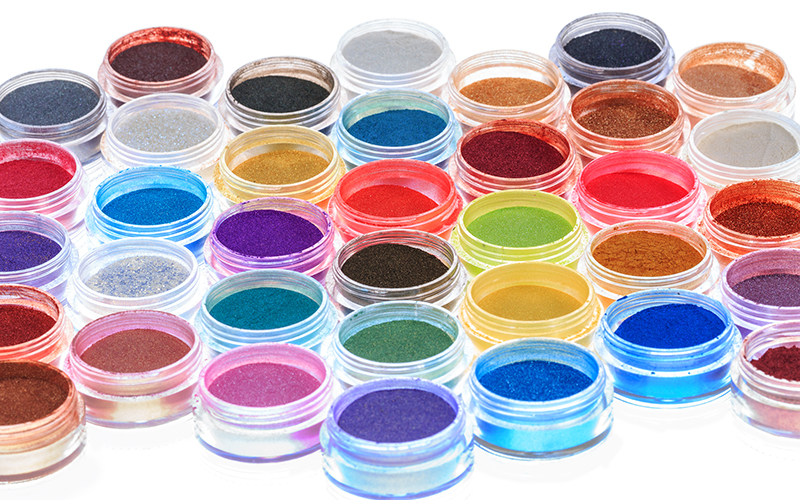Color additives in cosmetics continue to be a difficult topic. Blended colors are especially problematic. Keeping your products legal requires diligence and an understanding of color additives and the regulations.
Why “Blended Colors?”
A blended color additive is one that is made with a combination of color components. It may also have other ingredients to make them work.
Face it, there are only so many color additives permitted by the FDA for use in cosmetics. There are 29 ingredients (like mica or ultramarines) and 36 D&C or FD&C colors (the “dyes”). Of those dyes, there are only a few color groups: black (3), blue (2), green (4), orange (4), red (14), violet (2), and yellow (7). The only way to get all the unique colors out there is to blend approved colors to make new colors.
Think of all the nail polish or eye shadow colors on the market! Those contain blended combinations of approved color additives.
Who Makes Blended Color Additives?
There are huge companies that make color components—for cosmetics as well as other industries. Paint, for example, has very creative blends of color components, but paints don’t need to be approved for cosmetics. There are also some smaller companies that make or buy blended color additives and cater to handcrafted soap and cosmetic makers. Mad Micas comes instantly to mind.1
Selecting the Right Color Additive for Your Product
Not all color additives are equal. The trick comes in selecting the RIGHT color additive for your product. That is, a color additive that is LEGAL to use in your product.
A note about soap:
If you are making soap that is exempt from the definition of a cosmetic, you aren’t restricted to color additives approved for use in cosmetics. HOWEVER, you are still responsible for the safety of your soap. Consider carefully if you want to use a color additive that hasn’t been approved for use in cosmetics and on the human body, and if you do want to use it anyway, make sure it is safe for use.
Besides the color itself being what you want, here are some things to look for in deciding which color additive to use:
1. Has the Supplier Said it is “Not for Cosmetic Use”?
Generally that means that it contains a color additive that isn’t approved for cosmetics. Don’t use it in a cosmetic product. Consider carefully whether you want to use it in soap.
2. Has the Supplier Provided the Component Ingredients of the Color Additive?
It is your responsibility to put all the component ingredients in your ingredient declaration (and to ensure that they are safe). If the supplier doesn’t provide you with the list of component ingredients, you are at risk. Choose a different color additive if at all possible (or a different supplier).
3. Are All the Component Color Additives Matched for the Intended Use of Your Product?
The FDA’s chart of color additives for cosmetics lists the approved use of each. Many of the color additives have restrictions, so be sure to check the list.
General Use: Can be used generally, including in lipstick (but not eye area, unless specifically approved for such).
Eye-area: All around the eye, including the eyebrow. Lakes are not approved for eye-area use except if specifically stated.
Externally applied cosmetics: External body, except for eye area and lips (or any area covered by mucous membrane). If a color is rated for “external” use, you can’t use it for lip products unless it is specifically approved for such.
NOTE: Color additives in bath products, such as bath fizzies or bubble bath, do come in contact with mucous membranes (genital area, mostly). When I queried the FDA about this, I was informed via email that color additives approved for external use would be acceptable for in-bath products because of the small quantity of contact. This is not specifically stated on their website and the regulations may (or may not) be interpreted in this manner by an inspector. Be wary.
4. If There is a Component in the Blended Color Additive that is Not on the Approved List, is it Actually a Color Additive?
In some cases, a blended color additive might contain other ingredients that don’t need to be on the approved color additive list. An example is tin dioxide, which is used as a bulking agent, opacifier, or texturizing agent. If there is something in the ingredient list that isn’t an approved color additive, check with the supplier to see what its purpose is. Normally it would be added to the ingredient declaration with the other, non-color, ingredients.
Bottom Line
If a cosmetic contains a color additive that is not approved for the way it’s being used, the cosmetic is “adulterated.” That means the product is illegal.
The bottom line is that if you make a cosmetic product, you are responsible for ensuring that your product isn’t adulterated through containing a non-approved color additive.
-
Only use approved color additives in cosmetics.
-
Keep records.
-
Protect yourself and your business.

Shameless plug!
To really be able to create your own labels that comply with the regulations, get my book from Amazon and use it.
4th Edition – Released March 5, 2025!!!
Or order directly from me (and get a signed copy)!
- I want to thank Joanna Schmidt of Mad Micas for her assistance in understanding the color additive industry. ↩︎


Leave a Reply